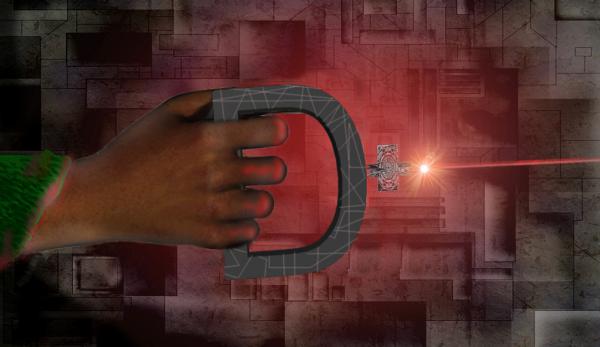BY LETTER
Omnitool
Technology > Application > Everydaytech
Technology > Technology Levels > High Tech / Hitech
Technology > Application > Materials Technology
Technology > Technology Type or Material > Nanotech
Technology > Technology Type or Material > Syntech/Synanotech
Technology > Technology Levels > High Tech / Hitech
Technology > Application > Materials Technology
Technology > Technology Type or Material > Nanotech
Technology > Technology Type or Material > Syntech/Synanotech
Reconfigurable handheld tool | |
 Image from Steve Bowers | |
| Omnitools change their shape to suit their function, but often include a handle and a D-shaped active area | |
An omnitool is a general class of hand-held technology capable of performing a variety of functions either on demand or after some internal reconfiguration. Primitive omnitools date from the Interplanetary Age (descended from midtech "multitools") and aside from the dark ages immediately after the Technocalypse, omnitools have been extant up to the current era.
Whilst sophistication and form vary greatly, a standard omnitool primarily consists of shape changing smart matter specialised for exceptionally high strength, toughness and melting temperatures. Most forms are capable of increasing their volume by 64x, low by the standards of other smart matter but with far higher durability. If required manual controls for requesting different forms can be generated on the surface, along with a suitable screen and audio interface. However most models are designed to interface with a DNI and be controlled by thought. For simple uses this is a case of thinking of the task and the omnitool will select the appropriate tool function, at more complex levels cortex-modules will be uploaded into the exoself allowing the user to operate an omnitool as easily and naturally as their own limbs (may require significant installation time). Some omnitools are configured to operate as handtech, replacement limbs for clades that do not possess hands or other manipulative appendages.
Embedded within the smart matter can be found power storage media, computronium and a variety of tool components. These components consist of everything one would need to make a sophisticated tool with the exception of the casing or any other physical support structure, instead this is provided by the smart matter. Keeping with the ethos of the tool these components are designed to compress, collapse and dismantle to smaller parts, thus occupying very tiny volumes when not in use. When requested an omnitool unpacks a component with the smart matter providing physical support. Individual component size varies but commonly when compressed they will resemble a cuboid pellet 100-1000ul in volume. To further save space omnitools employ modular design, if two tools require a motor and aren't expected to be used concurrently only one motor will be used. Using the same tools for different yet similar functions, such as diamondoid microscales for any cutting requirement be it blade, saw or burrower, can further maximise the number of components carried.
Due to the very compressed nature of the technology an omnitool can have hundreds of different functions. Basic functions consist of simple mechanical actions like hammering, cutting, sawing, screwing, drilling, milliscale manipulation, etching, carving, scrubbing, wiping, planning, bracing, lifting and forming containers. Beyond that an omnitool is only limited by its size with larger volumes possessing more components. Standard designs also contain cutting/grinding/striking materials, lasers, plasma cutters, voltmeters, magnetometer, spectrographs, RADAR/LIDAR measurement, chemicanalysers, chemical synthesisers (may require mattercache and added water as solvent), ultrasound emitters, genesticks, mechanosynthesis annealers/disassemblers, synsect caches and many more.
Tool components can be removed and added easily, even with hundreds of functions a user might need to carefully customise what pellets to place into their omnitool. As the maximum number of this is determined by volume the bigger the omnitool the more capable it will be. Mid-sized models are large enough to be wielded with two hands with much of the extra volume reserved for batteries, allowing for much more energetic work. Examples of more advanced versions are large enough to be worn as gauntlets, harnesses and even suits. These can contain much larger tools such as effector frames, personal transport and forge integrated technology. There are even cybernetic designs that can take the form of a limb, this is particularly popular amongst cultures who put a strong value on personal construction over bots.
Many popular omnitool models are also capable of independent actions, utilising their smart matter to form appropriate bodies. At higher levels of autonomy such devices are no longer regarded as omnitools but as gelbots.
Related Articles
- Aldrin Tools
- Gelbot
- Hand-held Lasers
- Handtech
- Laser
- Materials Science - Text by M. Alan Kazlev
The study and application of the nature and properties of various materials, including alloys, ceramics, composites, gels, membranes, polymers, synthetics, and biological materials, as well as completely neohylogenic nano materials, on the macro, micro, nano, and pico scale. - Mattercache
- Programmable Matter, Smart Matter
Appears in Topics
Development Notes
Text by Ryan B
Initially published on 12 May 2015.
Initially published on 12 May 2015.






